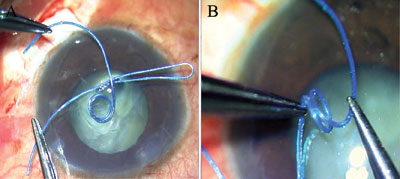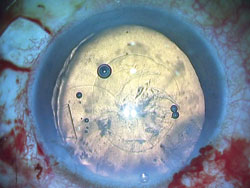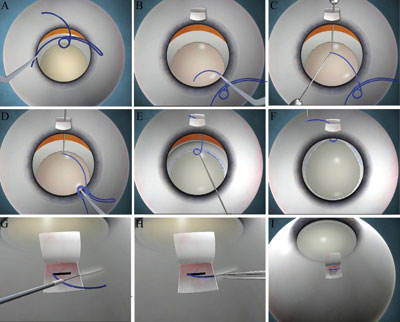Glued endocapsular hemi-ring segment makes surgery easier, faster
Surgeons describe the technique involved in implanting a device made of IOL haptic material.
 Amar Agarwal |
Suture fixation of the capsular bag to the scleral wall has been the standard means of tackling a subluxation of more than 3 to 4 clock hours. The problems involved in this technique are the greater surgical expertise that is required for manipulating the long, thin needle and suture as well as the greater surgical time taken. Issues secondary to usage of the suture for fixation, such as erosion, degradation, knot exposure and knot unraveling as well as delayed IOL subluxation or dislocation due to broken sutures, are other limitations of this technique.
We describe a new device made of polyvinylidene fluoride (PVDF), which is essentially IOL haptic material that allows sutureless fibrin glue-assisted transscleral fixation of the capsular bag. This device was designed by Dr. Jacob.
Glued endocapsular hemi-ring
The device is a single-piece structure made of PVDF with two arms that lie in the fornix of the capsular bag, with one arm looping back to reach the center of the ring segment (Figure 1a). This arm then winds into a 2.5-mm diameter double-scrolled structure (similar to the single-scrolled structure of the Malyugin ring) (Figure 1b) and then extends tangentially into the haptic of the glued endocapsular hemi-ring (ECHR) segment. The double scrolls engage the rhexis margin, and the haptic fixates the entire capsular bag to the sclera, as in a glued IOL. The length of the device from the tip of one arm to the other is 14 mm, although the device may be manufactured in different lengths according to surgeon preference and degree of subluxation. The ring is manufactured by Mateen Amin (Epsilon). It is indicated for use in patients with subluxated cataracts, colobomatous lenses or subluxated IOL-bag complex.
 Figure 1. (A) The glued endocapsular hemi-ring segment. (B) Double scrolls of the device that engage the rhexis rim in an atraumatic manner. Images: Agarwal A |
Surgical technique
A partial-thickness scleral flap is made centered on the side with absent or weak zonules (Figure 2). Phacoemulsification is then performed.
 Figure 2. Scleral flap made at the area of the subluxation. |
Anterior vitrectomy is done for any vitreous that is prolapsed into the anterior chamber through the area of dialysis. The rhexis is created, avoiding excessive traction on the zonules. Utrata or micro-rhexis forceps may be used if required to complete the rhexis (Figure 3). Hydrodissection is gently performed to loosen capsulo-cortical adhesions, taking care not to churn up cortex. A 20-gauge needle is used to create a sclerotomy under the scleral flap, taking care that the needle does not puncture the capsular bag. A cohesive viscoelastic injected under the iris at the site of zonular dialysis creates space and pushes the iris upward to make this step easier.
 Figure 3. Animation showing the implantation of the glued endocapsular hemi-ring segment. |
The next step is to introduce the glued ECHR segment into the anterior chamber through the main port. The haptic is caught in the jaws of end-gripping microforceps (MicroSurgical Technology) that have been introduced through the sclerotomy. Using the handshake technique and another set of similar forceps inserted through the side port, the haptic is exchanged between the two hands until the surgeon holds the haptic at its extreme tip with the microforceps passed under the scleral flap. The haptic is exteriorized out, and at the same time, using the other hand, the rest of the ring segment is flexed into the anterior chamber by holding it at the scrolls. Because PVDF is flexible, it can be easily fishtailed into the anterior chamber single-handedly. This fishtailing technique as described by Angunawela and Little decreases the zonular stress that occurs during the insertion of any endocapsular ring.
Once inside, the two arms of the ring segment are inserted under the rhexis. The circular scrolls are manipulated with the microforceps to engage the rhexis margin between two circular loops of the scrolls. Once engaged, pulling the exteriorized haptic pulls the entire capsular bag complex and centers it. The haptic is cut, leaving behind a sufficient length to tuck into a scleral tunnel, similar to the Scharioth tuck also used in the glued IOL technique. This tunnel is created starting at the far edge of the scleral flap and curving toward the limbus with a 26-gauge needle. The tangentially oriented haptic is then tucked into this scleral tunnel. It winds around the eye, hugging the eye wall and hooking itself to the sclera, thus retaining the entire capsular bag complex in its centered position (Figure 4).
 Figure 4. Glued endocapsular ring in place. |
Phacoemulsification is carried out as usual, followed by epinucleus and cortex aspiration and IOL implantation in the bag. Further centering of the bag, if desired, is achieved easily by adjusting the degree of tuck of the haptic into the scleral tunnel. The scleral flap is then closed with Tisseel fibrin glue (Baxter). The conjunctiva is also closed with fibrin glue, as are the clear corneal incisions if desired.
Discussion
The new glued ECHR segment is of the same material and gauge (130 µm) used for manufacturing IOL haptics. Hence, it has a safe history of biocompatibility within the eye over prolonged periods. Our experience with the glued IOL, as well as that of Scharioth and others over the last 4 years, has also shown that this material is biocompatible within the scleral wall and remains in place without any significant long-term issues.
The glued ECHR segment also has advantages over sutured rings and segments in the ease and rapidity of surgery. Overall surgical time is reduced, as exteriorizing the segment is easy and fast and does not involve the use of thin, difficult-to-manipulate needles.
References:
- Agarwal A, Kumar DA, Jacob S, Baid C, Agarwal A, Srinivasan S. Fibrin glue-assisted sutureless posterior chamber intraocular lens implantation in eyes with deficient posterior capsules. J Cataract Refract Surg. 2008;34(9):1433-1438.
- Angunawela RI, Little B. Fish-tail technique for capsular tension ring insertion. J Cataract Refract Surg. 2007;33(5):767-769.
- Scharioth GB, Pavlidis MM. Sutureless intrascleral posterior chamber intraocular lens fixation. J Cataract Refract Surg. 2007;33(11):1851-1854.
- Amar Agarwal, MS, FRCS, FRCOphth, is director of Dr. Agarwal’s Eye Hospital and Eye Research Centre. Prof. Agarwal is the author of several books published by SLACK Incorporated, publisher of Ocular Surgery News, including Phaco Nightmares: Conquering Cataract Catastrophes, Bimanual Phaco: Mastering the Phakonit/MICS Technique, Dry Eye: A Practical Guide to Ocular Surface Disorders and Stem Cell Surgery and Presbyopia: A Surgical Textbook. He can be reached at 19 Cathedral Road, Chennai 600 086, India; fax: 91-44-28115871; email: dragarwal@vsnl.com; website: www.dragarwal.com.
- Disclosure: The authors have no relevant financial disclosures.

